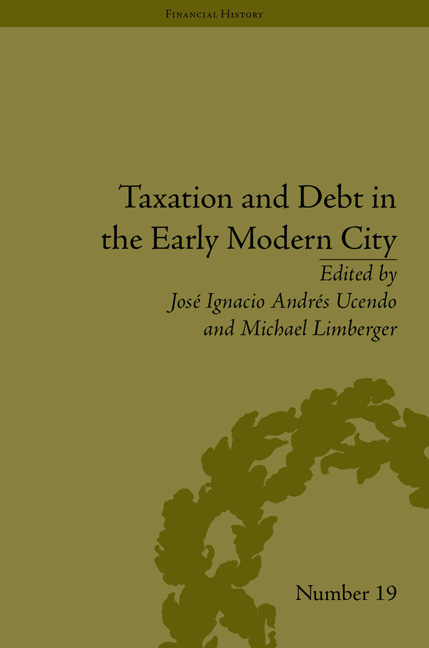Book contents
- Frontmatter
- CONTENTS
- Acknowledgements
- List of Contributors
- List of Figures and Tables
- Introduction
- 1 From Private to Public Management: Tax Farming and Customs Duties in Rome (1630–1700)
- 2 From Taxation to Indebtedness: The Urban Fiscal System of Milan during the Austrias Domination (1535–1706)
- 3 The Urban Tax System in the Kingdom of Naples (Seventeenth to Eighteenth Centuries)
- 4 Public Institutions, Local Politics and Urban Taxation in Seventeenth-Century Aragon
- 5 Taxation and Debt in the Early Modern Castilian Cities: The Case of Seventeenth-Century Madrid
- 6 Tax Collection in Spain in the Eighteenth Century: The Case of the ‘Décima’
- 7 Finances, the State and the Cities in France in the Eighteenth Century
- 8 The Making of the Urban Fiscal System of Antwerp until 1800: Excises, Annuities and Debt Management
- 9 The Dutch Financial System between Public and Private Interests: Urban Debt (1500–1700)
- 10 The Urban Fiscal System in the Habsburg Monarchy: The Case of the Austrian Hereditary Lands in the Sixteenth to Eighteenth Centuries
- 11 Taxation and Debt in Early Modern German Cities
- Notes
- Works Cited
- Index
10 - The Urban Fiscal System in the Habsburg Monarchy: The Case of the Austrian Hereditary Lands in the Sixteenth to Eighteenth Centuries
- Frontmatter
- CONTENTS
- Acknowledgements
- List of Contributors
- List of Figures and Tables
- Introduction
- 1 From Private to Public Management: Tax Farming and Customs Duties in Rome (1630–1700)
- 2 From Taxation to Indebtedness: The Urban Fiscal System of Milan during the Austrias Domination (1535–1706)
- 3 The Urban Tax System in the Kingdom of Naples (Seventeenth to Eighteenth Centuries)
- 4 Public Institutions, Local Politics and Urban Taxation in Seventeenth-Century Aragon
- 5 Taxation and Debt in the Early Modern Castilian Cities: The Case of Seventeenth-Century Madrid
- 6 Tax Collection in Spain in the Eighteenth Century: The Case of the ‘Décima’
- 7 Finances, the State and the Cities in France in the Eighteenth Century
- 8 The Making of the Urban Fiscal System of Antwerp until 1800: Excises, Annuities and Debt Management
- 9 The Dutch Financial System between Public and Private Interests: Urban Debt (1500–1700)
- 10 The Urban Fiscal System in the Habsburg Monarchy: The Case of the Austrian Hereditary Lands in the Sixteenth to Eighteenth Centuries
- 11 Taxation and Debt in Early Modern German Cities
- Notes
- Works Cited
- Index
Summary
Introduction
The early modern Habsburg monarchy was a complex structure of diverse and locally administered territories, and, likewise, the fiscal system varied considerably. Therefore, it is only possible to consider towns in a specific part of the monarchy in the following study. Because of the great variety of fiscal systems within the Habsburg Monarchy, only the hereditary lands – the core lands – will be examined here. Towns in these territories had similar systems of administration and taxation, and they also stood in a similar position, directly between the princely ruler (Landesfürst) and the territorial estates. From the end of the fifteenth and the beginning of the sixteenth century, princely rulers regularly raised taxes of different kinds. During the early modern period not only the height but also the sorts of taxes increased. The main reason of this was not so much the growing court expenditures, but the increasing military costs. Military expenditure was a main contributory factor which influenced the fiscal system during the entire period, starting with the Ottoman wars in the sixteenth century, which lasted until the eighteenth century, the Thirty Years’ War or the conflicts with France. So warfare was also an important factor in state formation in the Habsburg Monarchy.
No imperial city or city-state existed in the hereditary lands, therefore there were only two types of towns: the territorial and the seigniorial (grundherrschaftliche) towns.
- Type
- Chapter
- Information
- Taxation and Debt in the Early Modern City , pp. 167 - 180Publisher: Pickering & ChattoFirst published in: 2014



